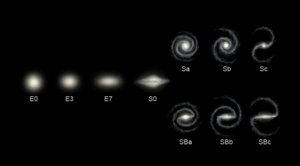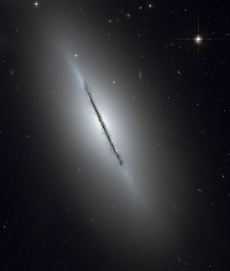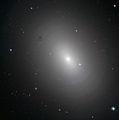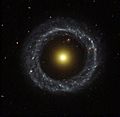Galaxy facts for kids
- For the automobile, see Ford Galaxy.
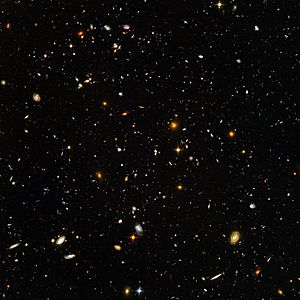

A galaxy is a huge group of many stars, along with gas, dust, and dark matter. The word 'galaxy' comes from the Greek word galaxia, which means milky. This refers to our own galaxy, the Milky Way.
Gravity is the force that holds galaxies together. It stops them from spreading out with the general expansion of the universe. This means the universe expands between groups of galaxies, but not inside them. The mass of a galaxy keeps it together, just like gravity holds groups of galaxies (like our Local Group) together. Everything in a galaxy moves around a central point called the centre of mass, which is also due to gravity.
There are different kinds of galaxies, such as elliptical, spiral, and lenticular galaxies. Some have a bar shape in the middle, and some don't. There are also irregular galaxies. All galaxies exist within the universe. Scientists think there are over 170 billion (1.7x1011) galaxies in the part of the universe we can see.
Contents
What Are Galaxies Like?
Galaxies come in many different sizes. Some are tiny, called dwarf galaxies, with as few as ten million (107) stars. Others are giant galaxies with a hundred trillion (1014) stars. All these stars orbit the galaxy's center of mass. Galaxies can also have many star clusters and huge clouds of gas and dust. Our Sun is one of the stars in the Milky Way galaxy. The Solar System includes Earth and all the other planets and objects that orbit the Sun.
Star clusters are not galaxies themselves; they are found inside galaxies. Globular clusters are tight, ball-shaped groups of stars that are part of the outer edge of the Milky Way. One of the biggest and oldest known star clusters, Messier 15, has millions of stars packed very close together. It even has a black hole at its center. These clusters have more stars than some of the smaller galaxies.
Inside galaxy clusters, galaxies move around and can even crash into each other. When galaxies collide, their stars usually pass by each other without hitting. However, the gas and dust clouds interact strongly, which can cause many new stars to form very quickly. Gravity pulls both galaxies into new shapes, creating bars, rings, or tail-like structures.
Many galaxies, like the Milky Way and other spiral galaxies, are still forming new stars. They create one or two new stars each year. These stars form in the huge clouds of gas and dust that make up about 1% to 10% of these galaxies. Globular star clusters, however, stopped forming stars billions of years ago once all their gas and dust were used up.
Types of Galaxies
Galaxies are mainly divided into three types: ellipticals, spirals, and irregulars. The Hubble sequence is a way to classify galaxies based on how they look. However, this system might not show everything important about a galaxy, like how fast it forms stars or if its center is very active.
Elliptical Galaxies
Elliptical galaxies are shaped like an ellipsoid, which is like a stretched-out sphere. They look elliptical no matter which way you view them. They don't have much structure, like spiral arms, and usually have very little gas and dust. This means they don't form many new stars. Instead, they are full of older stars that orbit the center in random directions. These stars have fewer heavy elements because star formation stopped after an early burst. In some ways, they are similar to the much smaller globular clusters.
The biggest galaxies are giant ellipticals. Many elliptical galaxies are thought to form when other galaxies crash and merge together. They can become huge, much larger than spiral galaxies. Giant elliptical galaxies are often found in the middle of large groups of galaxies. When galaxies collide, it can cause a burst of new star formation, which can lead to the creation of an elliptical galaxy.
Spiral Galaxies
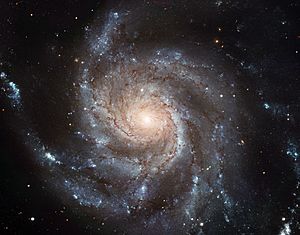
Spiral galaxies look like giant spiraling pinwheels. Most of their stars and visible material are in a flat disk. However, most of the mass in spiral galaxies is in a roughly spherical cloud of dark matter that extends beyond the visible part.
Spiral galaxies have a spinning disk of stars and gas, plus a central bulge of older stars. Bright arms spiral outwards from this central bulge. In the Hubble system, spiral galaxies are called type S. A letter (a, b, or c) is added to show how tightly wound the spiral arms are and how big the central bulge is. An Sa galaxy has tightly wound, unclear arms and a large core. An Sc galaxy has open, well-defined arms and a small core.
It seems that how fast a spiral galaxy spins affects whether it is fat and bulging or a flat disk.
The spiral arms in these galaxies are shaped like logarithmic spirals. This pattern can happen when something disturbs a group of stars that are spinning evenly. The spiral arms rotate around the center, but they do so at a constant speed. Scientists think the spiral arms are areas where matter is more dense, like "density waves". As stars move through an arm, their speed changes because of the stronger gravity. The arms are bright because the higher density helps new stars form, so they have many bright, young stars.
Many spiral galaxies, including our own Milky Way, have a straight, bar-shaped band of stars that stretches out from the center. This bar then connects to the spiral arms. In the Hubble system, these are called SB galaxies, followed by a letter (a, b, or c) to describe the spiral arms. Bars are thought to be temporary structures. They might form from a density wave moving out from the center or from a tidal interaction with another galaxy. Many barred spiral galaxies are very active, possibly because gas is pulled into their core along the arms.
Our galaxy, the Milky Way, is a large, disk-shaped barred-spiral galaxy. It is about 30 kiloparsecs wide and one kiloparsec thick. It has about two hundred billion (2×1011) stars and a total mass of about six hundred billion (6×1011) times the mass of the Sun.
Other Galaxy Shapes
Peculiar galaxies are galaxies that have unusual shapes because they have interacted with other galaxies. An example is a ring galaxy, which has a ring of stars and gas surrounding a bare center. A ring galaxy is thought to form when a smaller galaxy passes right through the center of a spiral galaxy. This might have happened to the Andromeda Galaxy, as it shows a multi-ring shape when seen in infrared light.
A lenticular galaxy is a type of galaxy that is in between an elliptical and a spiral galaxy. These are classified as Hubble type S0. They have a central bulge like a spiral but lack clear spiral arms, instead having a smooth, disk-like shape.
Besides these, there are galaxies that don't fit neatly into elliptical or spiral categories. These are called irregular galaxies. An Irr-I galaxy has some structure but doesn't match the Hubble classification. Irr-II galaxies have no clear structure and might have been disrupted. Nearby examples of (dwarf) irregular galaxies include the Magellanic Clouds.
Dwarf Galaxies
Even though large elliptical and spiral galaxies are well-known, most galaxies in the Universe are dwarf galaxies. These galaxies are quite small compared to other galaxies, being about one hundredth the size of the Milky Way. They contain only a few billion stars. Very small dwarf galaxies, called ultra-compact dwarf galaxies, have recently been found that are only 100 parsecs across.
Many dwarf galaxies can orbit a single larger galaxy. The Milky Way has at least a dozen such satellite galaxies, and scientists think there might be 300–500 more waiting to be discovered. Dwarf galaxies can also be classified as elliptical, spiral, or irregular. Since small dwarf ellipticals don't look much like large ellipticals, they are often called dwarf spheroidal galaxies instead.
A study of 27 galaxies near the Milky Way found that all dwarf galaxies have a central mass of about 10 million solar masses. This is true whether the galaxy has thousands or millions of stars. This suggests that galaxies are mostly made of dark matter. The minimum size might show a type of warm dark matter that can't clump together gravitationally on a smaller scale.
Galaxy Interactions and Activity
Interacting Galaxies
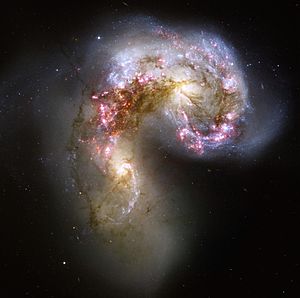
Galaxies often interact with each other. These interactions are very important for how galaxies change over time. When galaxies pass close to each other, their gravity can pull and stretch them, causing distortions. This can also lead to an exchange of gas and dust between them.
Collisions happen when two galaxies pass directly through each other. If they are moving fast enough, they won't merge. The stars usually don't hit each other, but the gas and dust inside the galaxies interact. This can sometimes trigger a burst of new star formation. A collision can greatly change the shape of galaxies, forming bars, rings, or tail-like structures.
The most extreme interactions are galactic mergers. In this case, the galaxies aren't moving fast enough to pass through each other. Instead, they slowly combine to form one larger galaxy. Mergers can cause big changes to the shapes of the original galaxies. If one galaxy is much bigger than the other, it's called cannibalism. The larger galaxy stays mostly the same, while the smaller one is torn apart. Our Milky Way galaxy is currently absorbing the Sagittarius Dwarf Elliptical Galaxy and the Canis Major Dwarf Galaxy.
Starburst Galaxies
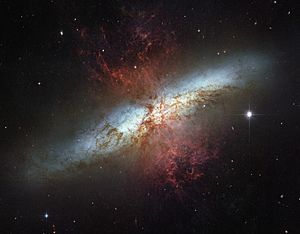
Stars form in galaxies from cold gas that gathers into giant molecular clouds. Some galaxies form stars at an amazing rate, which is called a starburst. If they kept this up, they would use up all their gas much faster than the galaxy's lifespan. So, starburst activity usually lasts for only about ten million years, which is a short time in a galaxy's history. Starburst galaxies were more common when the Universe was young. Today, they still create about 15% of all new stars.
Starburst galaxies have dusty areas of gas and many newly formed stars. These include huge stars that light up the surrounding clouds, creating H II regions. These massive stars explode as supernovas, creating expanding remnants that strongly affect the nearby gas. These explosions can start a chain reaction of star formation that spreads through the gassy region. The starburst stops only when almost all the gas is used up or spread out.
Starbursts often happen when galaxies are merging or interacting. A great example of this is M82, which had a close encounter with the larger M81. Irregular galaxies often show patches of starburst activity.
Active Galaxy Centers
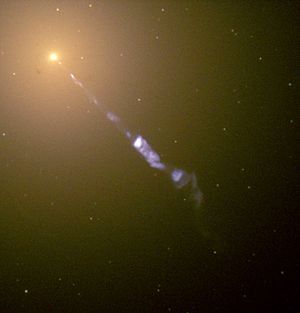
Some galaxies are called active. This means a lot of their total energy doesn't come from stars, dust, or gas. Instead, it comes from a different source.
The usual idea for an active galactic nucleus (AGN) is that it has an accretion disc around a supermassive black hole (SMBH) at its center. The light and energy from an AGN come from the gravitational energy of matter as it falls from the disc towards the black hole. In about 10% of these objects, two powerful jets of particles shoot out from the center in opposite directions, moving almost at the speed of light. Scientists are still trying to fully understand how these jets are made.
Active galaxies that give off high-energy radiation like x-rays are called Seyfert galaxies or quasars, depending on how bright they are. Blazars are thought to be active galaxies with a jet pointed right at Earth. A radio galaxy sends out radio waves from its jets. A single model helps explain how these different types of active galaxies are related, based on the angle from which we view them.
Related to active galaxy centers (and also to starburst regions) are low-ionization nuclear emission-line regions (LINERs). The light from LINER-type galaxies is mostly from weakly ionized elements. About one-third of nearby galaxies are thought to have LINER centers.
Related pages
- List of galaxies
- List of nearest galaxies
- Most distant things
- Local Group
- IC 1101: the largest known galaxy, with about 100 trillion stars.
Images for kids
-
The shape of the Milky Way as estimated by William Herschel in 1785. He thought our Solar System was near the center.
-
Photograph of the "Great Andromeda Nebula" by Isaac Roberts, 1899. This was later identified as the Andromeda Galaxy.
-
Hoag's Object, an example of a ring galaxy.
-
Different parts of near-infrared light seen by the Hubble Space Telescope in deep-sky surveys.
-
LEFT: ARP-MADORE2115-273 is a rare pair of interacting galaxies in the southern sky. RIGHT: ARP-MADORE0002-503 is a large spiral galaxy with unusual, long spiral arms, about 490 million light-years away.
See also
 In Spanish: Galaxia para niños
In Spanish: Galaxia para niños


